Roofing Compound - A joint-free and elegant roof
If you save your roof, you have a safe house
Watch out for the roofs weak points. What shape is your roof in? If you have a paper, sheet metal or eternite roof which is five years old or older, then it is high time you checked on it. No insurance policy reimburses leakage damages caused by deficient maintenance. If you wait too long, the damage will become very expensive; in addition you may have to relay the entire roof. All roofs are strongly affected by sunlight, but also by air pollutants and flue gases from the chimney. Cracks, dryness and blisters in the roof paper are warning signs you have to take seriously. Rust spots on metal roofs are also alarming. If you have a flat roof, you risk water pooling in depressions and channels which can cause long-term problems. Joints and connections around the chimney and vent holes must also be carefully inspected. |
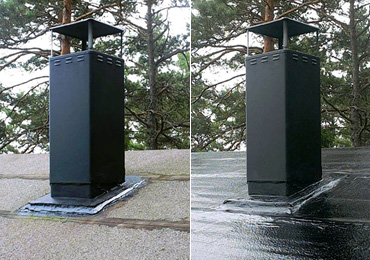
Before After |
Three important requirements
 Good adhesion. For satisfactory long-term protection, it is important that the maintenance product interacts with the foundation as well as possible. Hagmans has chosen to use a thinner as a solvent since this seeps down and absorbs into the foundation in a beneficial way.
Good adhesion. For satisfactory long-term protection, it is important that the maintenance product interacts with the foundation as well as possible. Hagmans has chosen to use a thinner as a solvent since this seeps down and absorbs into the foundation in a beneficial way.
Water resistant. The roof must withstand the all elements, including heavy downpours, for long periods of time. It must also withstand water collection which often builds up in depressions and channels. Hagmans roof maintenance products are carefully tested to withstand tough conditions and the surface will not dissolve or be damaged, even if it starts to rain directly after the work has been completed.
Weather resistant. The roof is affected by the sunlight and those pollutants in the air, such as flue gases from the chimney. Hagmans products are strong and durable, delivering satisfactory protection for many years.
Instructions:
Paper roofs - Single coating
| Recommended for a light renovation of existing paper roofing where the paper is not in too poor a condition or is not too old, or where full reinforcement has already been laid on the roof. The substrate must be completely clean and dry. Paper bubbles or similar must be adjusted (use Hagmans Asphalt Cement and Hagmans Asphalt Glue) so that the surface is smooth and a good result is achieved. Larger area of damage and cracks above beams are reinforced using Hagmans Reinforcement Netting. The roof compound is usually spread out with a roof brush in the longitudinal direction of the paper and out towards the overlay so that the joints are filled. The amount of material used should be approx. 0.8kg/m², depending on the surface structure and quality of paper. |
Sheet-metal roof - Single coating
| Clean the roof of any dirt and remove any old paint and rust by scraping or blasting. Prime any rust-corroded metal surfaces with Hagmans Rustproofing Primer/Metal Primer. Cracks and holes can easily be repaired with Hagmans Asphalt Cement or Hagmans Asphalt Glue. Larger repairs should be reinforced with Hagmans Reinforcement Netting. The roof compound is normally applied with a roof brush and with a paintbrush for coating the edges. Material consumption should be between 0.5-0.7kg/m². |
Paper roofs - Full reinforcement
Step 1The substrate must be completely clean and dry. Paper bubbles or similar must be adjusted (use Hagmans Asphalt Cement/Putty and Hagmans Asphalt Glue) so that the surface is smooth and a good result is achieved. Larger damages and cracks above beams are reinforced using Hagmans Reinforcement Netting. |
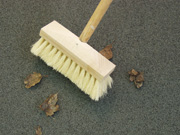 |
Step 2The first layer is laid in the same way as the single coating. The amount of material used should be approximately 1.0kg/m², depending on the surface structure and quality of paper. The roof compound is applied to the same width as that of the reinforcement netting. |
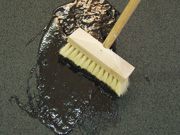 |
Step 3Lay the reinforcement netting in the underlying papers longitudinal direction. The entire surface must ‘be covered‘ with the brush so that the reinforcement is pressed down into the roof compound. |
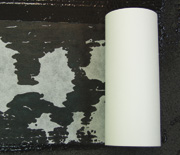 |
Step 4Finally, a fully covering layer of roof compound is laid (between 1.25-1.5kg/m²). The entire procedure is repeated and the reinforcement is overlaid each time by between 3 to 5cm. The upper layer of the roof compound is spread out with long brush strokes so that the surface becomes as smooth as possible. At connections, the reinforcement is laid up a few cm so that the paper fold is reinforced and the risk of leakage is minimised. Hoods, shafts and other details are coated completely or else the roof compound can be drawn up approximately 5cm and finished with a straight edge. |
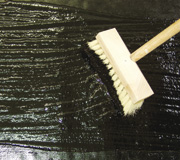 |
Instructions